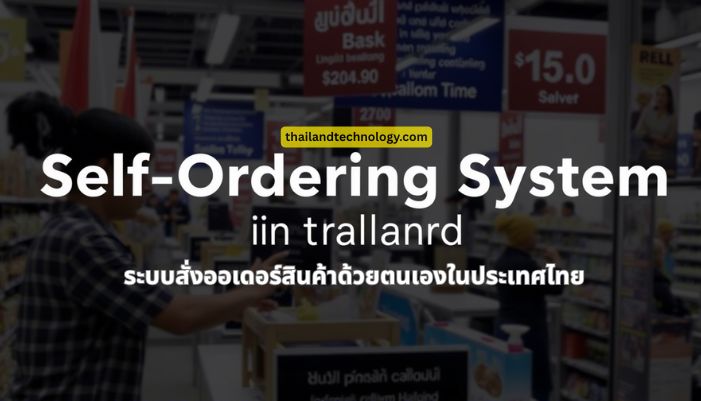Introduction
The digital revolution has transformed how businesses serve customers worldwide, and Thailand is no exception. One of the most remarkable advancements in recent years is the self ordering system in Thailand – ระบบสั่งออเดอร์สินค้าด้วยตนเองในประเทศไทย. From restaurants to retail stores, these systems are reshaping the customer experience by combining convenience, speed, and accuracy. As Thai businesses adapt to a more tech-driven economy, self-ordering has become a symbol of modernization and efficiency.
What Is a Self Ordering System?
A self ordering system allows customers to browse products, customize their orders, and make payments without relying on a cashier or sales attendant. Typically operated through digital kiosks, tablets, or mobile applications, this technology streamlines transactions and minimizes human error. In Thailand, both large chains and small local stores are increasingly adopting these systems to meet customer expectations for faster, more personalized service.
Growing Popularity Across Thailand
The self ordering system in Thailand – ระบบสั่งออเดอร์สินค้าด้วยตนเองในประเทศไทย has gained popularity in restaurants, coffee shops, and fast-food outlets. Brands like McDonald’s, KFC, and Café Amazon have introduced interactive kiosks that let customers select meals, add toppings, or choose portion sizes instantly. Beyond the food industry, self-ordering is expanding into retail, cinemas, and convenience stores. The Thai market’s openness to innovation and high smartphone penetration make it an ideal environment for these technologies to thrive.
Benefits for Businesses and Customers
1. Efficiency and Speed
Businesses can handle more orders in less time. Self-ordering kiosks reduce waiting lines, allowing restaurants to process orders even during peak hours. Customers appreciate the quick, hassle-free experience that lets them order at their own pace.
2. Reduced Labor Costs
Automation allows businesses to operate with fewer staff members while maintaining or improving service quality. For small business owners, this is particularly beneficial as it minimizes operational expenses without sacrificing customer satisfaction.
3. Improved Accuracy and Customization
Human error in taking orders is a common problem in traditional setups. With a digital system, customers input exactly what they want, reducing miscommunication and waste. The visual interface also allows customers to see images of menu items or products, which enhances confidence in their purchase decisions.
4. Enhanced Customer Data Insights
Self-ordering systems collect valuable data on customer preferences, peak ordering times, and popular items. This information enables businesses to refine menus, manage inventory more effectively, and personalize promotions to improve sales performance.
Technology Behind the Trend
Modern self ordering systems in Thailand often integrate with POS (Point of Sale) platforms, inventory management software, and digital payment gateways. Many systems also offer multilingual support to serve tourists, reflecting Thailand’s role as a global travel destination. Touchscreen kiosks, QR code menus, and mobile app-based systems are now standard across urban areas like Bangkok, Chiang Mai, and Pattaya.
Impact of the Pandemic on Adoption
The COVID-19 pandemic accelerated the adoption of self ordering systems in Thailand. With social distancing and hygiene becoming top priorities, contactless ordering solutions emerged as a safer and more efficient alternative. Customers became more comfortable using digital tools, and businesses quickly recognized their value in maintaining operations during restrictions. This shift not only improved health safety but also permanently changed how Thai consumers interact with food and retail environments.
Challenges and Considerations
While the advantages are clear, the implementation of self ordering systems comes with challenges. Small businesses may face high initial investment costs, and technical maintenance requires consistent support. Some customers, particularly older generations, may still prefer traditional interactions. Therefore, a hybrid approach—offering both digital and human service—often works best during the transition phase.
The Future of Self Ordering in Thailand
As Thailand continues to embrace digital transformation, the future of self ordering systems looks promising. Integration with AI, voice commands, and facial recognition technology could further personalize the experience. Moreover, partnerships between tech developers and local businesses are expected to make these systems more affordable and accessible across different industries. In the coming years, self-ordering will likely become a standard expectation, not just an innovation.
Conclusion
The self ordering system in Thailand – ระบบสั่งออเดอร์สินค้าด้วยตนเองในประเทศไทย represents more than just a trend—it’s a reflection of Thailand’s evolving business landscape. With its blend of convenience, accuracy, and efficiency, it empowers both consumers and business owners. As technology continues to evolve, Thailand’s journey toward a fully digital retail and dining experience will undoubtedly inspire other nations seeking to modernize their service industries.
